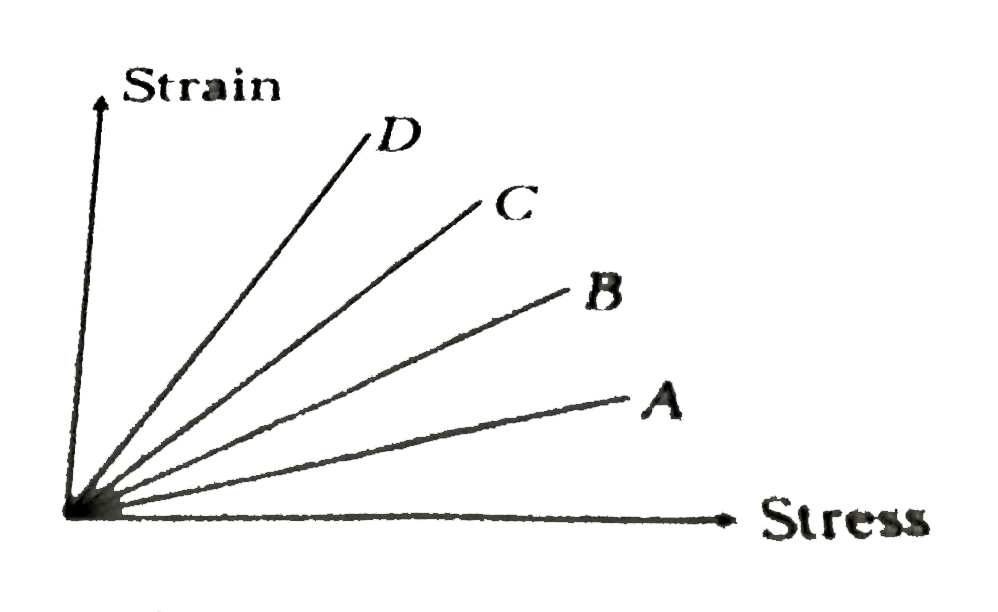Assertion: Ratio of stress and strain is always constant for a substance.
Reason : This ratio is called modulus of elasticity .
(a) If both Assertion and Reason are true and the Reason is correct explanation of the Assertion.
(b) If both Assertion and Reason are true but Reason is not the correct explanation of Assertion.
(c) If Assertion is true, but the Reason is false.
(d) If Assertion is false but the Reason is true.
The correct Answer is:D
To solve the question, we need to analyze the assertion and the reason provided.
1. Understanding the Assertion:
- The assertion states that the ratio of stress to strain is always constant for a substance.
- Analysis: This statement is not true for all conditions. The ratio of stress to strain (stress/strain) is constant only within the elastic limit of a material. Beyond this limit, the material may undergo plastic deformation, and the ratio will no longer remain constant.
2. Understanding the Reason:
- The reason states that this ratio is called the modulus of elasticity.
- Analysis: The modulus of elasticity (also known as Young's modulus for tensile stress) is defined as the ratio of stress to strain within the elastic limit. Therefore, this statement is correct.
3. Conclusion:
- Since the assertion is incorrect (the ratio is not always constant), but the reason is correct (the ratio is called modulus of elasticity), we conclude that the assertion is false while the reason is true.
Final Answer:
- The assertion is false, and the reason is true. Therefore, the correct answer is that the assertion is incorrect, and the reason is correct.
- The assertion states that the ratio of stress to strain is always constant for a substance.
- Analysis: This statement is not true for all conditions. The ratio of stress to strain (stress/strain) is constant only within the elastic limit of a material. Beyond this limit, the material may undergo plastic deformation, and the ratio will no longer remain constant.
- The reason states that this ratio is called the modulus of elasticity.
- Analysis: The modulus of elasticity (also known as Young's modulus for tensile stress) is defined as the ratio of stress to strain within the elastic limit. Therefore, this statement is correct.
- Since the assertion is incorrect (the ratio is not always constant), but the reason is correct (the ratio is called modulus of elasticity), we conclude that the assertion is false while the reason is true.
- The assertion is false, and the reason is true. Therefore, the correct answer is that the assertion is incorrect, and the reason is correct.
Topper's Solved these Questions
- BOOK - DC PANDEY ENGLISHCHAPTER - ELASTICITYEXERCISE - Level 1 Single Correct16videos
ELASTICITY
- BOOK - DC PANDEY ENGLISHCHAPTER - ELASTICITYEXERCISE - Level 1 Subjective8videos
ELASTICITY
- BOOK - DC PANDEY ENGLISHCHAPTER - ELASTICITYEXERCISE - Exercise 15.22videos
ELASTICITY
- BOOK - DC PANDEY ENGLISHCHAPTER - CURRENT ELECTRICITYEXERCISE - All Questions469videos
CURRENT ELECTRICITY
- BOOK - DC PANDEY ENGLISHCHAPTER - ELECTROSTATICSEXERCISE - Integer17videos
ELECTROSTATICS
Similar Questions
Knowledge Check
- Question 1 - Select One
Assertion : For small deformations, the stress and strain are proportional to each other.
Reason: A class of solids called elastomers does not obey Hooke's law.ABoth assertion and reason are true and reason is the correct explanation of assertion.BBoth assertion and reason are true but reason is not the correct explanation of assertion.CAssertion is true but reason is false.DBoth assertion and reason are false. - Question 2 - Select One
Assertion : Strain is a unitless quantity.
Reason : Strain is equivalent to forceABoth Assertion and Reason are true and Reason is the correct explanation of Assertion.BBoth Assertion and Reason are true but Reason is not the correct explanation of Assertion.CAssertion is true but Reason is false.DBoth Assertion and Reason are false.
Assertion :- Entropy is always constant for a closed system.
Reason :- Closed system is always reversible.View SolutionAssertion : For a certain amount of an ideal gas, PV is always constant at constant temperature.
Reason : This is the statement of Boyle's Law.View SolutionIn the following questions, a statement of assertion is followed by a statement of reason. Mark the correct choice as
(a) If both assertion and reason are true and reason is the correct explanation of assertion.
(b) If both assertion and reason are true but reason is not the correct explanation of assertion.
(c ) If assertion is true but reason is false.
(d) If assertion and reason are false.
Q. Assertion: Bulk modulus of elasticity B represents incompressibility of the material
Reason: B=−△P△VV, where symbols have their usual meaning.View SolutionYoung's modulus of elasticity is the ratio of
View SolutionAssertion If length of a wire is halved, its Young's modulus of elasticity will become two times.
Reason The ratio of longitudinal stress and longitudinal strain is called Young's modulus of elasticity.View SolutionStress-strain curve for four metals are shown in figure. The maximum Young's modulus of elasticity is for metal
 View Solution
View Solution

